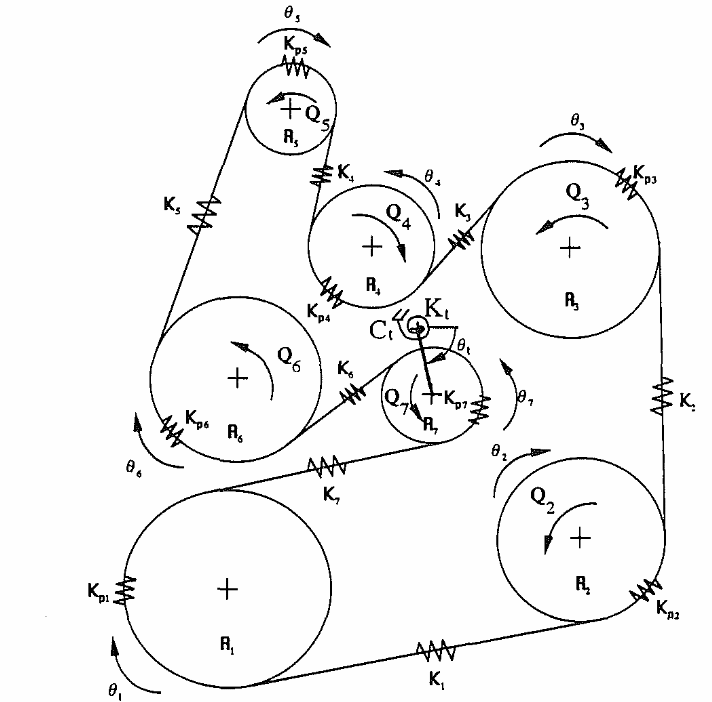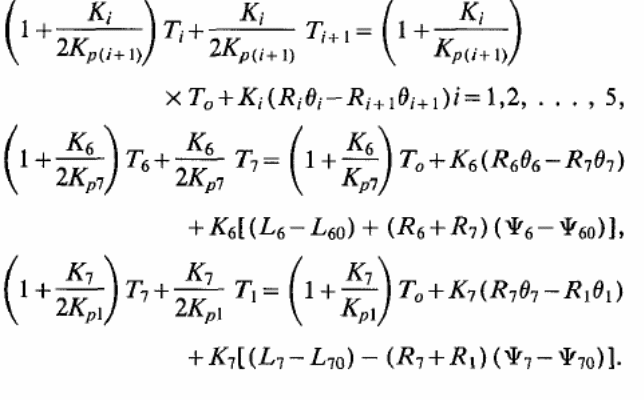Summary
This paper is a summary of the “rotational response and slip prediction of serpentine belt drive systems”, answers the question on the importance of a large wrap angle, and examines the elements that might be lacking in the model that Hwang’s model possesses by conducting a comparative study of the two models.
Rotational response model
An assembly of the accessory pulleys of the wheels driven by an inside belt operating under the automatic tensioner provides positive rotations on the wheels using the circular torque from the crankshaft. The assembly shows the relationship between the system elements in the following diagram.

In this case, the torque in the pulleys is indicated by the tension on the belts, which are indicated by the values of the linear spring constants k. It is assumed that the belt stretches in a quasi-static manner which is calculated by dividing tensile modulus by the length of the belt per portion. The length of each portion of the belt, the free span, and the modulus of the belt are important elements to consider.
Equitation of motion
The equation of motion of the tension subsystem and the driving shaft is formulated by using the moment of inertia of the tensioner arm about the pivot, installed tensioner arm, tensioner pulley, tensioner spring preload, the mass of the tensioner, the distance between the tensioner arm and pulley, and the angle of the tensioner arm, which results into a series of equations 8 nonlinear equations, with equation 6-8 shown below.

Equilibrium and vibration analysis
The equations of equilibrium are derived from the equations of motion by eliminating time derivatives with several variables, in this case, over 13. Accessory torque, tensioner stiffness, torque preloaded, and the operating speed, which influence the rotational vibration characteristics of the system.
Slip analysis
Importance of a large wrap angle
The next model provides a drive for the entire accessories assembly with the idler pulley integrated to increase the wrap angle around the alternator and pump pulleys. The wrap angle is provided to increase the tension, the length of the pulley under the drive of the belt, and the contact time with the drive belt.
Comparison of the models
The similarities with the models are that the tension in the belt, the angles of movement of the accessories, the friction between the serpentine belt and the pulley wheels can be modified depending on the tension that is applied on the belt by the action of the automatic tensioner. Hwang’s model allows for the application of constant tension on the serpentine belt using the automatic tensioners and the other model allows for constant tension to be applied on the serpentine belt irrespective of the speed of the belt and the wheels, and is affected by the cross sectional area of the belt. The new model reacts to the torque reacts to the torque produced and depends on the number of cylinders, while the Hwang’s model does not.
Unique differences in the models
The uniqe differences between the models are that the centre of the pulley for the second mode is not allowed to move while for the firt model it is allowed to auttomatically and depends on the porevailing operating conditions. Hwang’s model the results show that the state tension and slip predictions for static and dynamic loads can be modelled and calculated based on belt tension speed, tensioner and belt stiffness and orientation.